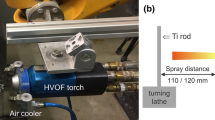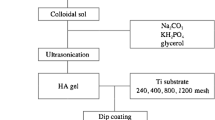Abstract
Mussel adhesion phenomena in nature have inspired the integration of inorganic hydroxyapatite (HA) crystals within versatile materials. One example is the simple, aqueous, two-step functionalization approach, called polydopamine-assisted hydroxyapatite formation (pHAF), which consists of the chemical activation of material surfaces via polydopamine coating and the growth of hydroxyapatite in a simulated body fluid (SBF). For this study, we anticipated that such a polydopamine coating on the surface of titanium (Ti) alloy would improve the ability of cementless stems to osseointegrate. We compared the in vitro ability of cells to adhere to polydopamine-coated Ti alloy and machined Ti alloy. We performed energy-dispersive x-ray spectroscopy (EDS) and scanning electron microscopy (SEM) investigations to assess the structure and morphology of the surfaces. Biological and morphological responses to osteoblast cell lines (MC3T-E1) were then examined by measuring cell proliferation, cell differentiation (alkaline phosphatase (ALP) activity), and actin filament formation. Real-time polymerase chain reaction (PCR) was used to analyze gene expression for osteocalcin, osteonectin, and osteoprotegerin. Cell proliferation and ALP activity in the polydopamine-coated Ti alloy did not differ statistically compared to the other group. The polydopamine-coated Ti alloy exhibited better apatite formation ability than the untreated alloy, as evidenced by apatite formation after SBF immersion for 10 days. Molecular biological analysis did not differ statistically between the groups. The surface modification of the Ti alloy by coating with polydopamine did not change the biological properties of the Ti alloy. This may make some difficulties for osteogenesis signaling for the cells.
Similar content being viewed by others
Reference
WN Capello, JA D’Antonio, JR Feinberg, et al., Ten-year results with hydroxyapatite-coated total hip femoral components in patients less than fifty years old. A concise follow-up of a previous report, J Bone Joint Surg Am, 85, 885 (2003).
YH Kim, JS Kim, SH Oh, et al., Comparison of porous-coated titanium femoral stems with and without hydroxyapatite coating, J Bone Joint Surg Am, 85, 1682 (2003).
J Parvizi, PF Sharkey, WJ Hozack, et al., Prospective matchedpair analysis of hydroxyapatite-coated and uncoated femoral stems in total hip arthroplasty. A concise follow-up of a previous report, J Bone Joint Surg Am, 86, 783 (2004).
O Reikerås, RB Gunderson, Excellent results of HA coating on a grit-blasted stem: 245 patients followed for 8–12 years, Acta Orthop, 74, 140 (2003).
Le Guehennec, A Soueidan, P Layrolle, et al., Surface treatments of titanium dental implants for rapid osseointegration, Dent Mater, 23, 844 (2007).
YL Chang, D Lew, JB Park, et al., Biomechanical and morphometric analysis of hydroxyapatite-coated implants with varying crystallinity, J Oral Maxillofac Surg, 57, 1096 (1999).
SL Wheeler, Eight-year clinical retrospective study of titanium plasma-sprayed and hydroxyapatite-coated cylinder implants, Int J Oral Maxillofac Implants, 11, 340 (1996).
H Lee, NF Scherer, PB Messersmith, Single-molecule mechanics of mussel adhesion, Proc Natl Acad Sci U S A, 103, 12999 (2006).
J Ou, J Wang, S Liu, et al., Microtribological and electrochemical corrosion behaviors of polydopamine coating on APTS-SAM modified Si substrate, Appl Surf Sci, 256, 894 (2009).
S Chen, Y Chen, Y Lei, et al., Novel strategy in enhancing stability and corrosion resistance for hydrophobic functional films on copper surfaces, Electrochem Commun, 11, 1675 (2009).
JH Waite, Adhesion a la moule, Integr Comp Biol, 42, 1172 (2002).
D Crisp, G Walker, G Young, et al., Adhesion and substrate choice in mussels and barnacles, J Colloid Interface Sci, 104, 40 (1985).
VV Papov, TV Diamond, K Biemann, et al., Hydroxyargininecontaining polyphenolic proteins in the adhesive plaques of the marine mussel Mytilus edulis, J Biol Chem, 270, 20183 (1995).
JH Waite, X Qin, Polyphosphoprotein from the adhesive pads of Mytilus edulis, Biochemistry, 40, 2887 (2001).
H Lee, SM Dellatore, WM Miller, et al., Mussel-inspired surface chemistry for multifunctional coatings, Science, 318, 426 (2007).
H Lee, J Rho, PB Messersmith, Facile conjugation of biomolecules onto surfaces via mussel adhesive protein inspired coatings, Adv Mater, 21, 431 (2009).
C Ohtsuki, H Kushitani, T Kokubo, et al., Apatite formation on the surface of ceravital-type glass-ceramic in the body, J Biomed Mater Res, 25, 1363 (1991).
M Tanahashi, T Yao, T Kokubo, et al., Apatite coating on organic polymers by a biomimetic process, J Am Ceram Soc, 77, 2805 (2005).
SW Taylor, DB Chase, MH Emptage, et al., Ferric ion complexes of a DOPA-containing adhesive protein from Mytilus edulis, Inorg Chem, 35, 7572 (1996).
N Holten-Andersen, TE Mates, MS Toprak, et al., Metals and the integrity of a biological coating: the cuticle of mussel byssus, Langmuir, 25, 3323 (2009).
WM Chirdon, WJ O’Brien, RE Robertson, Adsorption of catechol and comparative solutes on hydroxyapatite, J Biomed Mater Res B Appl Biomater, 66, 532 (2003).
Author information
Authors and Affiliations
Corresponding author
Rights and permissions
About this article
Cite this article
Lee, J.H., Lim, Y.W., Kwon, S.Y. et al. In vitro effects of mussel-inspired polydopamine coating on Ti6Al4V alloy. Tissue Eng Regen Med 10, 273–278 (2013). https://doi.org/10.1007/s13770-012-1089-y
Received:
Revised:
Accepted:
Published:
Issue Date:
DOI: https://doi.org/10.1007/s13770-012-1089-y




